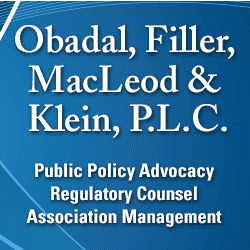MMT Spotlights Reciprocal Acceptance, D&A, SMS
The 2025 meeting of the Maintenance Management Team (MMT) took place in Ottawa the week of Sept. 8. The MMT brings together representatives from the FAA, European Union Aviation Safety Agency (EASA), Transport Canada Civil Aviation (TCCA), and Brazil’s Agência Nacional de Aviação Civil (ANAC) to coordinate maintenance aspects of the agencies’ bilateral relationships.
As part of the annual MMT, industry representatives spend a day coordinating priorities and a second day meeting with the authorities. ARSA Executive Vice President Christian Klein is the association’s representative.
Important takeaways from this year’s meeting:
- Change 10 to the FAA-EASA Maintenance Annex Guidance (MAG) was published in June and is now in force. Discussions about Change 11 have already begun.
- The Safety Management System (SMS) compliance deadline for U.S. repair stations with EASA approval is fast approaching. The deadline to develop, implement, and integrate SMS into the repair station’s manuals (including the EASA supplement), and operations is Dec. 31, 2025. Per the FAA’s Information for Operators (InFO), ‘For EASA part 145 certificate holders that have not established an SMS that meets the Special Condition by the October 10, 2025, deadline. The EASA Supplement revision required by that date must include a statement similar to: “SMS policies and procedures will be developed and implemented and the SMS declaration of compliance will be submitted to the FAA no later than December 31, 2025.’” More information about ARSA’s resources to help members meet SMS requirements is at https://arsa.org/sms-program/.
- Revision 2 (not yet available online) to the FAA-TCCA Maintenance Implementation Procedures (MIP) was signed on Sept. 9 and will go into effect on Nov. 8, 2025. TCCA Advisory Circular (AC) 571-002 and FAA AC 43-10C will be updated accordingly with publication by TCCA expected by the end of 2025 and by the FAA in late 2026.
- The FAA-ANAC MIP and MAG were republished on July 31, 2024 with minor editorial updates and rewording to allow standalone FAA repair stations in Brazil, repair station certificates to last for 24 months instead of 12, and both countries to “accept” (rather than “approve”) supplements.
- EASA-TCAA MAG Revision 3 has been fully implemented. TCCA AC 573-010 provides additional information, as does EASA’s “EASA Part 145 organisations located in Canada” webpage.
As part of the meeting, Klein updated industry colleagues and regulators about ARSA’s efforts surrounding the FAA’s new foreign repair station drug and alcohol requirements. He described the toolkit ARSA is developing to support member applications for exemptions and waivers, suggestions the association made to the agency to facilitate implementation, the related ARSA-led petition for rulemaking, and outreach to foreign governments. The FAA has indicated that it plans to issue related guidance before the end of 2025.
As requested by an ARSA-led rulemaking petition, Klein also continued to urge the FAA to amend part 43 to allow the agency to reciprocally accept foreign repair station certificates. Many of the bilaterals between TCCA, EASA, and ANAC provide for some form of mutual recognition (especially for component repair stations), thereby eliminating the need for additional certification and supplements. The United States’ failure to pursue similar arrangements because of language in part 43 has put U.S. repair stations at a competitive disadvantage.
For more updates on bilateral relationships between the leading authorities, be sure to attend the “Opening Salvo” panel with regulators at ARSA’s 2026 Annual Conference.
For more information about becoming involved in the MMT, ask ARSA.
Previous MMT meeting updates...
12/5/23 - Digitalization, SMS Loom Large at MMT
December 5, 2023
ARSA Executive Vice President Christian A. Klein returned from Cologne on Dec. 2 after participating in the annual Maintenance Management Team (MMT) meeting. Through the MMT, four of the leading aviation authorities – the FAA, the European Union Aviation Safety Agency (EASA), Transport Canada Civil Aviation, and Brazil’s Agência Nacional de Aviação Civil (ANAC) – meet and coordinate bilateral and multilateral activities. The meeting, which includes an industry day, provides an opportunity for stakeholders to raise issues to regulators and learn more about the status of bilateral negotiations.
Two topics were front and center at this year’s meeting: digitalization and Safety Management Systems (SMS). Klein presented the results of a survey conducted by ARSA and other MMT participants including the Aircraft Electronics Association (AEA) and the General Aviation Manufacturers Association (GAMA) about the use of digital technology in the global maintenance industry. Among other things, Klein reported that outdated policies and inconsistent interpretations are slowing digitalization, particularly in the areas of records and signatures.
Other conclusions of the survey:
- Technology is evolving more quickly than regulatory standards.
- Paper recordkeeping requirements inhibit safety improvement (data gathering, trend analysis, etc.)
- Industry is embracing digitalization when agency rules do not inhibit doing so.
- The lack of performance-based standards, regulations, guidance and policy is an impediment to adopting new and more efficient technologies.
The MMT Digitalization Working Group urged that future bilateral agreements allow for new formats for parts documentation to pave the way for unique identification of each part via RFID, Blockchain, and other technologies. Regulators were also urged to agree on maintenance data standards based on lessons learned from the sharing of operational data, to enhance data availability, and to facilitate the acceptance of multilateral releases for return to service.
AEA Vice President for Government and Industry Affairs Ric Peri led the SMS discussion. He reviewed the various authorities’ current SMS requirements for repair stations. Of particular note, effective Dec. 2, 2024, all EASA Part-145 approved maintenance organizations (i.e., those with certificates directly from EASA, not via a bilateral) must have implemented an SMS. While the FAA has foregone requiring SMS for repair stations, a future revision to the Maintenance Annex Guidance (MAG) for the FAA-EASA bilateral will extend the requirement to U.S. repair stations with EASA approval. (Note: ARSA members have access to AEA’s SMS resources. For more information, click here.)
Industry asked that regulators continue to accept the industry’s SMS standard as a means of compliance with existing regulations, coordinate to assure compatibility and alignment with future regulation, support approved maintenance organization (AMO) voluntarily adoption of the industry standard, and wait to implement SMS requirements via MAGs until after EASA Part 145 SMS requirements are fully implemented (i.e., post December 2024), allowing other repair stations to benefit from lessons learned during the implementation process.
Other important takeaways from the meeting:
- The FAA expects to sign new Maintenance Implementation Procedures (MIP) with TCCA in the second quarter of 2024 and expects to sign an updated MAG (Rev. 9) with EASA next year.
- TCCA and ANAC plan to ink a new Technical Arrangement – Maintenance (TA-M) in January 2024; it will only require supplement approvals for organizations performing maintenance on products (aircraft, engines, and propellors).
- FAA and ANAC signed a MIP in 2018 and a MAG in 2023. Publication is expected early next year.
- EASA and TCCA are on track to sign a revised Annex B providing in the first quarter of 2024.
- A revision to Annex B of the EASA-ANAC bilateral went into effect in March 2023.
11/13/18 - Simple Math – Counting Bilaterals in a Quadrilateral Group
November 13, 2018
On Nov. 6-9, the Maintenance Management Team (MMT) met in Brasilia, Brazil to discuss a variety of international issues affecting their respective bilateral maintenance agreements. Sometimes referred to as the “quadrilateral group,” the MMT consists of representatives from the National Civil Aviation Agency of Brazil (ANAC), the European Aviation Safety Agency (EASA), the FAA and Transport Canada Civil Aviation (TCCA). The MMT is the maintenance equivalent of the Certification Management Team (CMT) involving the same four authorities.
As implied by this article’s title, how many bilateral aviation safety agreements exist among and between the four authorities participating in the MMT? Read on to see the count.
Represented by its managing director & general counsel, Marshall Filler, ARSA was one of several industry associations that participated in the industry-authorities day on Nov. 9. (Industry representatives also met on Nov. 8.) Joining ARSA at the meetings were representatives from the General Aviation Manufacturers Association (GAMA), the Aerospace Industries Association of Brazil (AIAB), AIA Canada (AIAC) and the Modification and Replacement Parts Association (MARPA). Several large aerospace manufacturers/maintenance providers also attended including ARSA members Boeing, Airbus, Rockwell Collins and Gulfstream.
Industry urged the MMT authorities to work toward full mutual recognition of each other’s maintenance organizations, preferably on a multilateral basis. The authorities were receptive to the idea and plan to work toward this objective (EASA and TCCA already are). However, formal agreements will continue to be negotiated on a bilateral basis in the near term. MMT authorities indicated industry can still realize the benefits of mutual recognition, even if they are applied individually to the six* pairs of maintenance bilateral agreements that exist among the four authorities (FAA-TCCA, FAA-EASA, FAA-ANAC, EASA-TCCA, EASA-ANAC and TCCA-ANAC).
Among the significant issues discussed with industry were the anticipated December release of FAA-EASA MAG rev. 7, the newly-signed (but not yet effective) Maintenance Implementation Procedures (MIP) agreement between the FAA and ANAC, the revision to the TCCA-FAA MIP that will take effect in mid-November and the authorities’ contingency plans for a “hard” Brexit. In that regard, the FAA, TCCA and ANAC anticipate implementation of bilateral agreements necessary to maintain a similar aviation relationship with the United Kingdom as that which exists today. EASA is preparing for a hard Brexit by processing third country approval applications from UK companies, including those relating to maintenance.
Look for more details on the specific issues discussed during MMT week in the next issue of the hotline.
*If you answered the question posed by the headline correctly, take your significant other out to a nice dinner!
11/14/17 - ARSA Works with Quadrilateral Group Towards 'Practical Compliance'
November 14, 2017
On Nov. 9 and 10, the quadrilateral Maintenance Management Team (MMT), which is comprised of the FAA, Transport Canada, EASA and Brazil’s ANAC, met in Ottawa to discuss issues affecting existing bilateral maintenance agreements. The MMT is similar to the almost 10-year-old Certification Management Team (CMT), and the four authorities used this first official meeting to present governance plans including annual meetings and associated industry days. The group’s official charter will likely be finalized by the end of the year.
In preparation for the event, ARSA worked with several other industry trade associations to develop and execute the agenda for the Nov. 10 industry day:
Industry Day – Nov. 10 – Review
Participants were briefed on ICAO’s efforts to minimize duplication associated with the certification and surveillance (i.e., audits) of Approved Maintenance Organizations (AMOs). As most ARSA members know, most States of Registry require their own AMO certificates instead of approving or accepting those issued by other authorities. Although ICAO’s efforts will not affect the State of Registry’s authority over continued airworthiness it will, by developing more robust AMO guidance, encourage States to strongly consider approving or accepting the certificates issued by other authorities or, at the very least, rely on audits performed by other civil aviation authorities. This is clearly a step in the right direction although the results of the effort will not be known for many years.
Not surprisingly, parts documentation was discussed again – the participating groups (except for Transport Canada) addressed this topic during an unofficial meeting in June 2016 under the auspices of the FAA-EASA Joint Maintenance Coordination Board after the agencies’ International Safety Conference – including commercial and commercial off-the-shelf parts (COTS) parts and the current requirement in the Maintenance Annex Guidance (MAG) that they be accompanied by a Form 1 or 8130-3 when installed in maintenance subject to that agreement. Although EASA will soon issue a Notice of Proposed Amendment (NPA) to reduce the number of parts that will require Form 1 (perhaps setting the stage for subsequent MAG changes), the rulemaking process will take more time and is fraught with uncertainty.
In the meantime, industry reminded the two agencies that certificate holders have no practical compliance path because the vast majority of commercial and COTS parts are not traceable to a production approval holder and consequently are not accompanied by Form 1 or 8130-3 as required by the MAG (except for standard and fabricated parts). An ARSA-led industry coalition recommended a solution earlier this year (i.e., that the parts not require a Form 1 or 8130-3 if they are traceable to an approved design; a C of C would suffice). Unfortunately, the issue remains open although discussions between the two authorities are continuing.
More progress was made in the area of parts documentation associated with single releases for maintenance performed on aircraft. The issue is whether parts installed on a U.S.-registered aircraft in the European Union must have Form 8130-3 if only a single release is to be issued, which is normally the case for aircraft maintenance. Such parts should not require Form 8130-3, although the MAG states otherwise. ARSA is hopeful this will be addressed in MAG change 7.
Finally, Transport Canada is working to develop guidelines to accept work performed by appropriately-certificated maintenance facilities outside the geographical borders of the United States or Canada (or another country that does not have a maintenance agreement with Canada). The theory is that if Transport Canada or the FAA would accept work from an appropriately certificated organization inside the United States or Canada, why would they not recognize the same maintenance when performed by an FAA or TCCA certificate holder outside either country? The problem arises due to the geographic limitations inherent in most bilateral agreements although there are ways to address it if the authorities are willing to do so. The FAA and EASA have issued numerous “foreign” AMO certificates compared to a much smaller number for Canada and Brazil. If a maintenance facility in Mexico, for example, held an EASA Part-145 certificate but wanted to work on U.S. State of Registry articles, the FAA would require that it obtain an FAA foreign repair station certificate instead of recognizing its EASA certificate. EASA would do the same. Perhaps the two authorities should rethink this.
Industry is hoping the MMT will lead by example and eventually adopt mutual recognition of each other’s maintenance certificates without special conditions. It would set a positive example for the rest of the world and would not adversely affect the industry’s excellent safety record.








